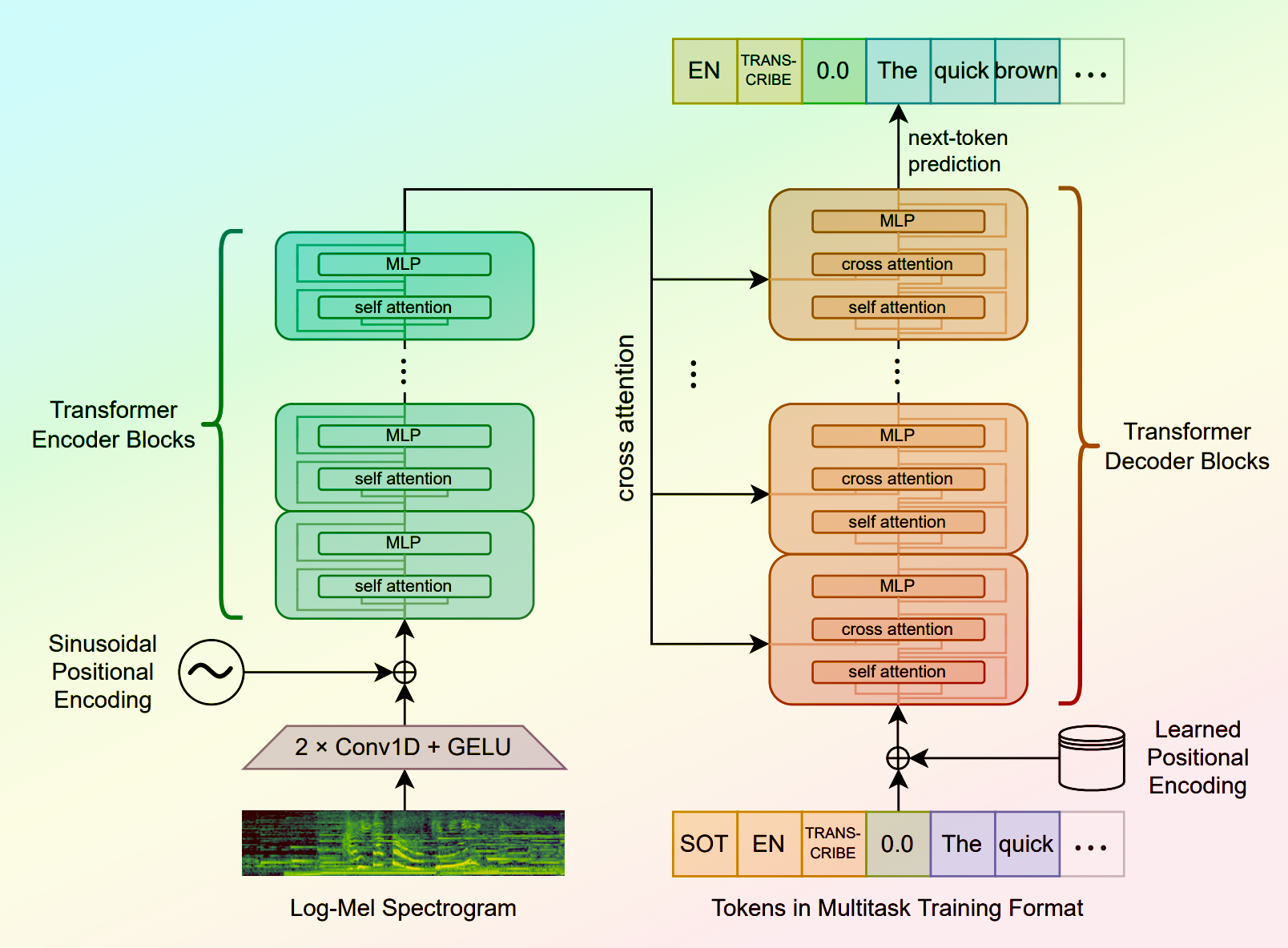whisper
Maintainer: soykertje

6
↗️
| Property | Value |
|---|---|
| Model Link | View on Replicate |
| API Spec | View on Replicate |
| Github Link | View on Github |
| Paper Link | No paper link provided |
Create account to get full access
Model overview
Whisper is a state-of-the-art speech recognition model developed by OpenAI. It is capable of transcribing audio into text with high accuracy, making it a valuable tool for a variety of applications. The model is implemented as a Cog model by the maintainer soykertje, allowing it to be easily integrated into various projects.
Similar models like Whisper, Whisper Diarization, Whisper Large v3, WhisperSpeech Small, and WhisperX Spanish offer different variations and capabilities, catering to diverse speech recognition needs.
Model inputs and outputs
The Whisper model takes an audio file as input and generates a text transcription of the speech. The model also supports additional options, such as language specification, translation, and adjusting parameters like temperature and patience for the decoding process.
Inputs
- Audio: The audio file to be transcribed
- Model: The specific Whisper model to use
- Language: The language spoken in the audio
- Translate: Whether to translate the text to English
- Transcription: The format for the transcription (e.g., plain text)
- Temperature: The temperature to use for sampling
- Patience: The patience value to use in beam decoding
- Suppress Tokens: A comma-separated list of token IDs to suppress during sampling
- Word Timestamps: Whether to include word-level timestamps in the transcription
- Logprob Threshold: The threshold for the average log probability to consider the decoding as successful
- No Speech Threshold: The threshold for the probability of the <|nospeech|> token to consider the segment as silence
- Condition On Previous Text: Whether to provide the previous output as a prompt for the next window
- Compression Ratio Threshold: The threshold for the gzip compression ratio to consider the decoding as successful
- Temperature Increment On Fallback: The temperature increase when falling back due to the above thresholds
Outputs
- The transcribed text, with optional formatting and additional information such as word-level timestamps.
Capabilities
Whisper is a powerful speech recognition model that can accurately transcribe a wide range of audio content, including interviews, lectures, and spontaneous conversations. The model's ability to handle various accents, background noise, and speaker variations makes it a versatile tool for a variety of applications.
What can I use it for?
The Whisper model can be utilized in a range of applications, such as:
- Automated transcription of audio recordings for content creators, journalists, or researchers
- Real-time captioning for video conferencing or live events
- Voice-to-text conversion for accessibility purposes or hands-free interaction
- Language translation services, where the transcribed text can be further translated
- Developing voice-controlled interfaces or intelligent assistants
Things to try
Experimenting with the various input parameters of the Whisper model can help fine-tune the transcription quality for specific use cases. For example, adjusting the temperature and patience values can influence the model's sampling behavior, leading to more fluent or more conservative transcriptions. Additionally, leveraging the word-level timestamps can enable synchronized subtitles or captions in multimedia applications.
This summary was produced with help from an AI and may contain inaccuracies - check out the links to read the original source documents!
Related Models

whisper

16.4K
Whisper is a general-purpose speech recognition model developed by OpenAI. It is capable of converting speech in audio to text, with the ability to translate the text to English if desired. Whisper is based on a large Transformer model trained on a diverse dataset of multilingual and multitask speech recognition data. This allows the model to handle a wide range of accents, background noises, and languages. Similar models like whisper-large-v3, incredibly-fast-whisper, and whisper-diarization offer various optimizations and additional features built on top of the core Whisper model. Model inputs and outputs Whisper takes an audio file as input and outputs a text transcription. The model can also translate the transcription to English if desired. The input audio can be in various formats, and the model supports a range of parameters to fine-tune the transcription, such as temperature, patience, and language. Inputs Audio**: The audio file to be transcribed Model**: The specific version of the Whisper model to use, currently only large-v3 is supported Language**: The language spoken in the audio, or None to perform language detection Translate**: A boolean flag to translate the transcription to English Transcription**: The format for the transcription output, such as "plain text" Initial Prompt**: An optional initial text prompt to provide to the model Suppress Tokens**: A list of token IDs to suppress during sampling Logprob Threshold**: The minimum average log probability threshold for a successful transcription No Speech Threshold**: The threshold for considering a segment as silence Condition on Previous Text**: Whether to provide the previous output as a prompt for the next window Compression Ratio Threshold**: The maximum compression ratio threshold for a successful transcription Temperature Increment on Fallback**: The temperature increase when the decoding fails to meet the specified thresholds Outputs Transcription**: The text transcription of the input audio Language**: The detected language of the audio (if language input is None) Tokens**: The token IDs corresponding to the transcription Timestamp**: The start and end timestamps for each word in the transcription Confidence**: The confidence score for each word in the transcription Capabilities Whisper is a powerful speech recognition model that can handle a wide range of accents, background noises, and languages. The model is capable of accurately transcribing audio and optionally translating the transcription to English. This makes Whisper useful for a variety of applications, such as real-time captioning, meeting transcription, and audio-to-text conversion. What can I use it for? Whisper can be used in various applications that require speech-to-text conversion, such as: Captioning and Subtitling**: Automatically generate captions or subtitles for videos, improving accessibility for viewers. Meeting Transcription**: Transcribe audio recordings of meetings, interviews, or conferences for easy review and sharing. Podcast Transcription**: Convert audio podcasts to text, making the content more searchable and accessible. Language Translation**: Transcribe audio in one language and translate the text to another, enabling cross-language communication. Voice Interfaces**: Integrate Whisper into voice-controlled applications, such as virtual assistants or smart home devices. Things to try One interesting aspect of Whisper is its ability to handle a wide range of languages and accents. You can experiment with the model's performance on audio samples in different languages or with various background noises to see how it handles different real-world scenarios. Additionally, you can explore the impact of the different input parameters, such as temperature, patience, and language detection, on the transcription quality and accuracy.
Updated Invalid Date
↗️
whisper

50
whisper is a large, general-purpose speech recognition model developed by OpenAI. It is trained on a diverse dataset of audio and can perform a variety of speech-related tasks, including multilingual speech recognition, speech translation, and spoken language identification. The whisper model is available in different sizes, with the larger models offering better accuracy at the cost of increased memory and compute requirements. The maintainer, cjwbw, has also created several similar models, such as stable-diffusion-2-1-unclip, anything-v3-better-vae, and dreamshaper, that explore different approaches to image generation and manipulation. Model inputs and outputs The whisper model is a sequence-to-sequence model that takes audio as input and produces a text transcript as output. It can handle a variety of audio formats, including FLAC, MP3, and WAV files. The model can also be used to perform speech translation, where the input audio is in one language and the output text is in another language. Inputs audio**: The audio file to be transcribed, in a supported format such as FLAC, MP3, or WAV. model**: The size of the whisper model to use, with options ranging from tiny to large. language**: The language spoken in the audio, or None to perform language detection. translate**: A boolean flag to indicate whether the output should be translated to English. Outputs transcription**: The text transcript of the input audio, in the specified format (e.g., plain text). Capabilities The whisper model is capable of performing high-quality speech recognition across a wide range of languages, including less common languages. It can also handle various accents and speaking styles, making it a versatile tool for transcribing diverse audio content. The model's ability to perform speech translation is particularly useful for applications where users need to consume content in a language they don't understand. What can I use it for? The whisper model can be used in a variety of applications, such as: Transcribing audio recordings for content creation, research, or accessibility purposes. Translating speech-based content, such as videos or podcasts, into multiple languages. Integrating speech recognition and translation capabilities into chatbots, virtual assistants, or other conversational interfaces. Automating the captioning or subtitling of video content. Things to try One interesting aspect of the whisper model is its ability to detect the language spoken in the audio, even if it's not provided as an input. This can be useful for applications where the language is unknown or variable, such as transcribing multilingual conversations. Additionally, the model's performance can be fine-tuned by adjusting parameters like temperature, patience, and suppressed tokens, which can help improve accuracy for specific use cases.
Updated Invalid Date

whisperx

41
whisperx is a Cog implementation of the WhisperX library, which adds batch processing on top of the popular Whisper speech recognition model. This allows for very fast audio transcription compared to the original Whisper model. whisperx is developed and maintained by daanelson. Similar models include whisperx-victor-upmeet, which provides accelerated transcription, word-level timestamps, and diarization with the Whisper large-v3 model, and whisper-diarization-thomasmol, which offers fast audio transcription, speaker diarization, and word-level timestamps. Model inputs and outputs whisperx takes an audio file as input, along with optional parameters to control the batch size, whether to output only the transcribed text or include segment metadata, and whether to print out memory usage information for debugging purposes. Inputs audio**: The audio file to be transcribed batch_size**: The number of audio segments to process in parallel for faster transcription only_text**: A boolean flag to return only the transcribed text, without segment metadata align_output**: A boolean flag to generate word-level timestamps (currently only works for English) debug**: A boolean flag to print out memory usage information Outputs The transcribed text, optionally with segment-level metadata Capabilities whisperx builds on the strong speech recognition capabilities of the Whisper model, providing accelerated transcription through batch processing. This can be particularly useful for transcribing long audio files or processing multiple audio files in parallel. What can I use it for? whisperx can be used for a variety of applications that require fast and accurate speech-to-text transcription, such as podcast production, video captioning, or meeting minutes generation. The ability to process audio in batches and the option to output only the transcribed text can make the model well-suited for high-volume or real-time transcription scenarios. Things to try One interesting aspect of whisperx is the ability to generate word-level timestamps, which can be useful for applications like video editing or language learning. You can experiment with the align_output parameter to see how this feature performs on your audio files. Another thing to try is leveraging the batch processing capabilities of whisperx to transcribe multiple audio files in parallel, which can significantly reduce the overall processing time for large-scale transcription tasks.
Updated Invalid Date

whisperspeech-small

1
whisperspeech-small is an open-source text-to-speech system built by inverting the Whisper speech recognition model. It was developed by lucataco, a contributor at Replicate. This model can be used to generate audio from text, allowing users to create their own text-to-speech applications. whisperspeech-small is similar to other open-source text-to-speech models like whisper-diarization, whisperx, and voicecraft, which leverage the capabilities of the Whisper speech recognition model in different ways. Model Inputs and Outputs whisperspeech-small takes a text prompt as input and generates an audio file as output. The model can handle various languages, and users can optionally provide a speaker audio file for zero-shot voice cloning. Inputs Prompt**: The text to be synthesized into speech Speaker**: URL of an audio file for zero-shot voice cloning (optional) Language**: The language of the text to be synthesized Outputs Audio File**: The generated speech audio file Capabilities whisperspeech-small can generate high-quality speech audio from text in a variety of languages. The model uses the Whisper speech recognition architecture to generate the audio, which results in natural-sounding speech. The zero-shot voice cloning feature also allows users to customize the voice used for the synthesized speech. What Can I Use It For? whisperspeech-small can be used to create text-to-speech applications, such as audiobook narration, language learning tools, or accessibility features for websites and applications. The model's ability to generate speech in multiple languages makes it useful for international or multilingual projects. Additionally, the zero-shot voice cloning feature allows for more personalized or branded text-to-speech outputs. Things to Try One interesting thing to try with whisperspeech-small is using the zero-shot voice cloning feature to generate speech that matches the voice of a specific person or character. This could be useful for creating audiobooks, podcasts, or interactive voice experiences. Another idea is to experiment with different text prompts and language settings to see how the model handles a variety of input content.
Updated Invalid Date